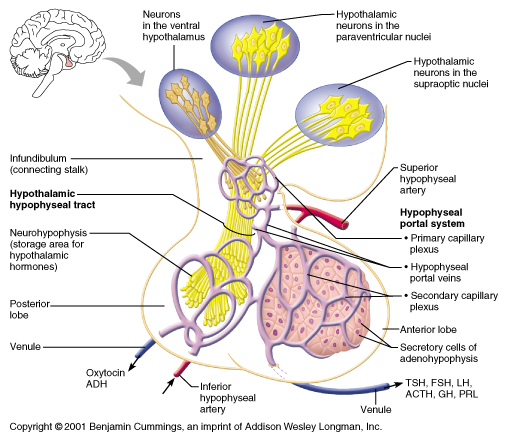W.B.C.S. Main 2018 Question Answer – Physiology – Hypothalamic Releasing Factors.
WBCS ২০১৮ মেইনস প্রশ্নের উত্তর – দেহতত্ব – হাইপোথ্যালামিক রিলিজিং ফ্যাক্টর।
Originally searched for and eventually isolated as factors of hypothalamic origin controlling anterior pituitary secretions, these hypophysiotropic peptides are now a chapter of physiology and medical endocrinology of their own. Defying the concept of ‘neuropeptides’ they and their receptors are now known to be ubiquitous and to have subtle as well as profound effects on a large number of functions of both soma and psyche. This review will be composed of brief essays on current knowledge of each of the original ‘hypothalamic hormones’, TRH, GnRH, somatostatin, GHRH and corticotropin releasing hormone and will close on possible and probable futures.Continue Reading W.B.C.S. Main 2018 Question Answer – Physiology – Hypothalamic Releasing Factors.
The pituitary gland is often portrayed as the “master gland” of the body. Such praise is justified in the sense that the anterior and posterior pituitary secrete a battery of hormones that collectively influence all cells and affect virtually all physiologic processes.
The pituitary gland may be king, but the power behind the throne is clearly the hypothalamus. As alluded to in the last section, some of the neurons within the hypothalamus – neurosecretory neurons – secrete hormones that strictly control secretion of hormones from the anterior pituitary. The hypothalamic hormones are referred to as releasing hormones and inhibiting hormones, reflecting their influence on anterior pituitary hormones.
Hypothalamic releasing and inhibiting hormones are carried directly to the anterior pituitary gland via hypothalamic-hypophyseal portal veins. Specific hypothalamic hormones bind to receptors on specific anterior pituitary cells, modulating the release of the hormone they produce.
As an example, thyroid-releasing hormone from the hypothalamus binds to receptors on anterior pituitary cells called thyrotrophs, stimulating them to secrete thyroid-stimulating hormone or TSH. The anterior pituitary hormones enter the systemic circulation and bind to their receptors on other target organs. In the case of TSH, the target organ is the thyroid gland.
Clearly, robust control systems must be in place to prevent over or under-secretion of hypothalamic and anterior pituitary hormones. A prominent mechanism for control of the releasing and inhibiting hormones is negative feedback. Details on the control of specific hypothalamic and anterior pituitary hormones is presented in the discussions of those hormones.
The following table summarizes the major hormones synthesized and secreted by the pituitary gland, along with summary statements about their major target organs and physiologic effects. Keep in mind that summaries are just that, and ongoing research continues to delineate additional, sometimes very important effects.
| Hormone | Major target organ(s) | Major Physiologic Effects | |
|---|---|---|---|
| Anterior Pituitary |
Growth hormone | Liver, adipose tissue | Promotes growth (indirectly), control of protein, lipid and carbohydrate metabolism |
| Thyroid-stimulating hormone | Thyroid gland | Stimulates secretion of thyroid hormones | |
| Adrenocorticotropic hormone | Adrenal gland (cortex) | Stimulates secretion of glucocorticoids | |
| Prolactin | Mammary gland | Milk production | |
| Luteinizing hormone | Ovary and testis | Control of reproductive function | |
| Follicle-stimulating hormone | Ovary and testis | Control of reproductive function | |
| Posterior Pituitary |
Antidiuretic hormone | Kidney | Conservation of body water |
| Oxytocin | Ovary and testis | Stimulates milk ejection and uterine contractions |
A final point to be made is that individual cells within the anterior pituitary secrete a single hormone (or possibly two in some cases). Thus, the anterior pituitary contains at least six distinctive endocrinocytes.
The cells that secrete thyroid-stimulating hormone do not also secrete growth hormone, and they have receptors for thyroid-releasing hormone, not growth hormone-releasing hormone. The image below is of a section of canine anterior pituitary that was immunologically stained for luteinizing hormone (black stain) and prolactin (purple stain). The unstained cells in the image are those that secrete the other pituitary hormones.
Our own publications are available at our webstore (click here).
For Guidance of WBCS (Exe.) Etc. Preliminary , Main Exam and Interview, Study Mat, Mock Test, Guided by WBCS Gr A Officers , Online and Classroom, Call 9674493673, or mail us at – mailus@wbcsmadeeasy.in
Visit our you tube channel WBCSMadeEasy™ You tube Channel
Please subscribe here to get all future updates on this post/page/category/website



 +919674493673
+919674493673  mailus@wbcsmadeeasy.in
mailus@wbcsmadeeasy.in






































































































